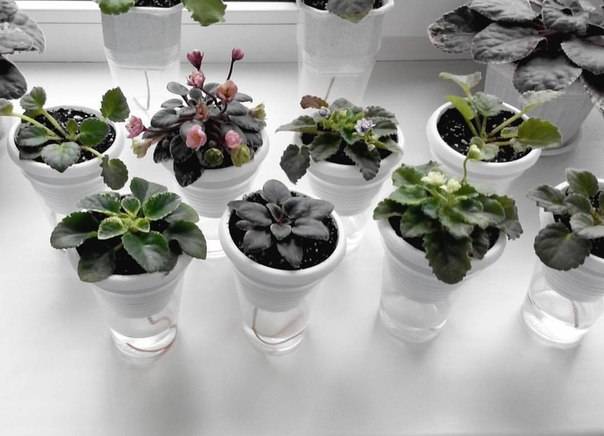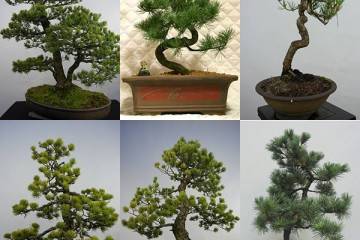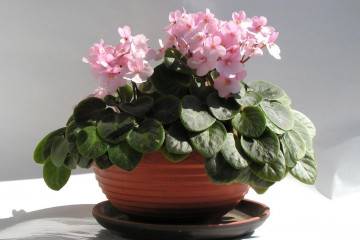Wick watering violets - how to do it yourself
Content:
Water is essential for the life and active development of plants. One of the ways to supply violets with life-giving moisture is wick irrigation. It allows you to provide flowers with the necessary nutrients, while reducing the time for caring for Saintpaulias, because traditional watering is a very laborious process, especially if the collection of plants is large.
The essence of the method of watering violets with a wick method
The wick method saves a lot of time and at the same time allows the plant to independently regulate the amount of liquid consumed, which minimizes the likelihood of drying out or excessive moisture.
A cord is used as a wick, which is threaded into the drainage hole of the flower pot. Part of the cord is placed in the lower third of the container for growing violets and covered with earth. The pot is placed on a water tank and the free end of the wick is placed in the water.
The water from the reservoir rises up the wick to the dry area, dampening the cord and the soil around it. Thus, with the correct selection of the diameter of the wick, the plant receives exactly the amount of water that it needs.
Pros and cons of transferring Saintpaulias to wick irrigation
There are several options for watering indoor plants, and each grower chooses the most suitable for himself. Along with the indisputable advantages, the wick method has several disadvantages.
The advantages of the method:
- Lack of laborious individual watering, which is especially important with a large number of violets.
- Optimum moisture intake for plant development.
- Long and abundant flowering of Saintpaulias when choosing the right concentration of fertilizers.
- There is no need for additional air humidification, since the amount of evaporated water provides the plant's need for moisture.
- Rapid production of adult flowering specimens as a result of an even and continuous supply of nutrients.
- Savings on the cost of land mixture and flower pots, since violets on wick irrigation need smaller containers and, accordingly, they also need less soil.
violets on the wicks do not require the daily attention of the grower. Having filled the tank with enough water, you can safely go on a business trip or vacation.
Disadvantages of wick irrigation:
- In the case of an incorrectly selected diameter of the wick, waterlogging of the land mixture and rotting of the plant are possible.
- Leaves become more fragile and break off easily when the plant is moved.
- In constantly moist soil, midges and mushroom mosquitoes can start.
Wick watering violets: how to make
To transfer plants to the wick irrigation method, it is necessary to prepare suitable containers, an earth mixture and the wick itself.
The bottom container, which will contain the nutrient solution, should be wider in size than the pot of soil. This can be a planter without a drainage hole or a plastic container. A transparent container is more convenient in that it makes it easy to observe the water level.
The containers in which the violets are directly located are ordinary flower pots with drainage holes. The diameter is selected based on the size of the outlet. For large specimens, containers of 9 cm in diameter are suitable, and a five-centimeter pot is enough for miniature Saintpaulias.
When flower growers decide what to make a wick for violets, they usually give preference to ropes made of synthetic materials, since the cord is in water for a long time, and natural fibers are prone to rotting. However, natural ropes or thick threads conduct water well, providing an excellent capillary effect. Therefore, cotton, woolen cords and even thin strips of felt are successfully used.
To prepare the wicks, the thin cord is cut into pieces about 15 cm long. The rope thickness usually ranges from one to three millimeters. The diameter and length of the wick may vary depending on the size of the pot and the depth of the water container.
The soil must be neutral. Horseback red peat with the addition of vermiculite or perlite is suitable. With the wick irrigation method, add as much baking powder as peat. The mixture is thoroughly mixed.
Assemble the structure as follows:
- The wick is passed through the pot and part of the cord is taken out.
- A violet is placed in a flower pot.
- Pour in the land mixture, while filling in the cord.
- The free part of the wick is lowered into a container with an aqueous solution, placing a pot with a violet on top of the container.
Top dressing with wick irrigation
To prepare the nutrient solution, water-soluble complex fertilizers are used. You can use "Nutrisol", "Kemiru-Lux" and others. During flowering, violets need fertilizing, which include phosphorus and potassium. It is advisable to take warm and settled water. Fertilizers in powder form are dissolved according to the instructions.
Violets tolerate a lack of fertilizer better than an excess, so do not overfeed them. It is better to make a weaker solution than too concentrated. The prepared nutrient solution is poured into a container.
Part of the cord must always be immersed in water, the wick must not be allowed to dry out. If necessary, add the solution. Usually this procedure is performed every three weeks.
The delicate root system of violets is sensitive to low temperatures, so the nutrient solution should not be cold. If the saintpaulias are on the windowsill, then it can be cool there in winter. In this case, the plants are either rearranged to a warmer place, or removed from the wick irrigation.
Transfer of Saintpaulias to wick irrigation
Mature, well-formed, healthy plants are easy to wick. First you need to prepare all the necessary elements of the wick system. Then the flower is carefully removed from the old pot, gently shaken off the ground and transplanted into a container with a wick. Violet roots are carefully sprinkled with prepared earthy mixture.
This method is also applicable for Saintpaulia babies, but in this case it is very important to choose the right cord. If the wick is too thick, children will die from waterlogging, and an excessively thin cord will not be able to provide young plants with the necessary nutrition.
Sometimes a mixed method of watering violets is used, combining wick and traditional methods. Saintpaulias at any age can be transferred to the wick and vice versa, the plant easily adapts to different methods of hydration.
Wick watering is also used for propagation by leaf cuttings. In this case, moss is used instead of the land mixture. Before planting, the cuttings can be treated with root roots. A pot with cuttings planted in moss is placed on a container with a solution and top watering is carried out. Then the system works as usual - the liquid enters as needed, rising along the cord.
You can make a wick system from improvised means, and this method of watering is suitable for almost all plants. Using watering on wicks, flower growers create the necessary conditions for the development of violets, while they themselves get the opportunity to leave the plants for 2-3 weeks without worrying about their green pets.




















